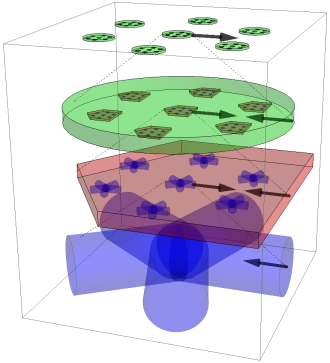


We propose refinement of a theory of correlations based on Kullback-Leibler divergence in living systems. The theory integrates the current understanding of thermodynamic emergence in physical systems with observations of correlation in metazoan communities. In both cases, the observations are organized around a hierarchical series of physical gradients and boundaries. We're qualified to do this integration with help from critical connections across disciplines, background in the conceptual underpinnings, and experience with problems spanning multiple scales of space-time and organization.
Thermodynamic emergence, e.g. Chaisson's cosmic evolution or the natural history of invention, generally involves reversible thermalization of available work to support the formation of subsystem correlations with respect to certain physical gradients and boundaries. The radial structure of a star, for instance, emerges from less well-defined structure in the cloud of gas and dust from which it forms. Thus stars and planets emerge in the presence of density and thermal gradients in their respective nurseries, making possible biochemical cycles on planetary surfaces that emerge in the presence of composition gradients. Thanks to sunlight-driven biochemical cycles, molecule surfaces and cell membranes define the inward and outward looking correlations that describe microbial life, just as organ surfaces and skins predicate the correlations that describe metazoan individuals. In a similar sense the physical boundaries that define metazoan communities beyond the skin are code-pool boundaries of two types: molecular (e.g. family gene-pools) and memetic (e.g. cultural idea-pools). In each case, correlations with respect to these latter boundaries facilitate quantitative as well as conceptual inventories of the subsystem correlations that we think of as community life.

Initially we propose to further develop a simplex model of layered niche networks along with the conceptual connections that underpin it. The simplex model associates six positive numbers (resource fractions directed toward the buffering of correlations in/out relative to skin, family and culture) with each metazoan. These numbers characterize a community's correlation network only in terms of the individual time and/or energy resources allocated to each layer. One objective is to explore ways to gather high-quality experimental data on the layer multiplicity of niche structures in a given metazoan community (via e.g. observation of behaviors, communication traffic, and for human communities development of survey instruments). Primary long-term goals are to examine the robustness of niche-level multiplicity as a measure of community health, and to examine the utility of multi-layer awareness as conceptual tool for tracking the healing effect of communications on communities. Possible application to displaced communities of metazoans will also be considered, with the simple objective there of going one step beyond body count in quantitatively assessing the impact of disasters and policy changes on a given community.

The strategy described will help to put biological evolution into a larger physical context, and to portray cultural beliefs and scientific observation as complementary elements of any memetically-active community. Conversely, it can be used to deconstruct extremist approaches that ignore that complementarity. The success that eukaryotes have at developing and sustaining individual metazoans, by informing molecular-code expression to multiple layers of organization, might thus be sought for human communities via attention to multi-level consistency in the expression of idea-codes. Thereby the need for (and impact of) awareness about media perspectives, and values informed to more than one scale, might be clarified or even quantified.
This approach is deeply integrative. That means that it provides new insight into a wide range of social patterns that have been independently discussed, like division of responsibility between large and small gamete metazoans, redirection of intra-species aggression, etc. In behavioral ecology, the approach will facilitate quantitative comparison of the extent and nature of community cultural-correlations, from one species to another or from one time to another for a given species. Particularly important questions arise when comparing the correlation networks operational in communities where humans evolved, to those networks that humans are being asked to participate in today.
Technical fields as diverse as thermodynamics, economics, anthropology, and the study of complex systems all suggest that a quantitative measure of community health may be important. Such a measure could serve as complement to gross domestic product if human communities make the transition to sustainability. Regardless, absent a concerted focus: the rate at which niche-level multiplicity erodes due to habitat modification and reduced free energy per capita will likely increase in non-human and human communities. Tracking this process may be a good idea.
